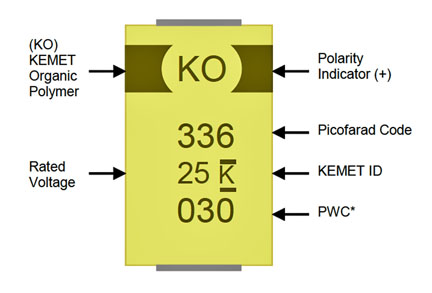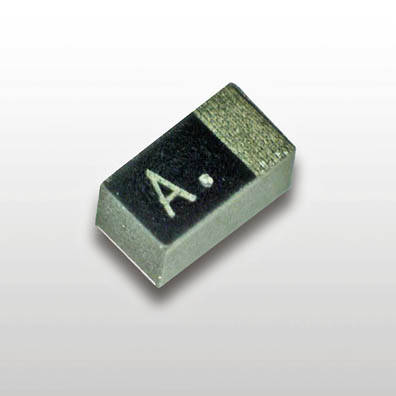Tantalum capacitors made with conducting polymer electrodes have been around for a dozen years now. For the first few years they were limited to low voltage — 5 V max. Now they go all the way to 125 V, though most manufacturers stop at 35 V. These devices have some significant advantages over “standard” Mn02 solid electrolyte capacitors.

First is their safety. Mn02 capacitors are sensitive to overvoltage spikes and can exhibit a potentially catastrophic failure and possible explosion when high currents are available. Although the natural polymer series failure mechanism is a short circuit, it does not exhibit an explosive failure mode because of its chemical composition. Another big feature is that voltage derating for polymer tantalum is significantly less than for traditional tantalum capacitors. Kemet recommends a 10% voltage derating for voltages less than 10 V, and 20% for over. For Mn02 , a 50% derating is typical.
Polymer tantalums also provide a considerably lower ESR — in the range of 6 to 150 mΩ for most value/voltage ratings. That can be lower by a factor of 2 to 3 than similar capacitors made with MnO2 . Unlike many ceramic capacitors, dc bias causes only a small reduction in capacitance, up to about 2% when full rated voltage is applied.

Typical surface-mount tantalum polymer capacitors
Some sample availability
Looking at one example of a standard solid tantalum cap, we’ll take a 47-µF 16-V Mn02 solid electrolyte tantalum SMT capacitor in the low ESR TPS family from AVX. We’ll look at both ±10% and ±20% tolerance — sometimes the 10% is actually cheaper. It comes in a C or D SMT package and is rated for 85°C. The C package version has an ESR of 350 mΩ, or optionally 110 mΩ, at 100 kHz. A quick look at pricing shows the 350-mΩ version costs just $0.28 ea/500. In the larger D-size package, TPSD476K016 comes in four ESR levels — as low as 80 mΩ. This 80-mΩ part costs $1.16 ea/500. The 150-mΩ version actually costs a bit more at $1.25 — go figure. These are just some snapshot prices.
Now, a look at the AVX TCJ series tantalum polymer capacitor TCJY476M016#0045. This series comes only in ±20% tolerance, but is rated for 105°C (vs. 85 for the nonpolymer). It uses a Y case that is a somewhat thinner D size, and the 100-kHz ESR is just 45 mΩ. Pricing is $1.03 ea/500. There is a 70-mΩ version that should be less expensive — but once again, it actually costs a few cents more than the 40-mΩ one. I’ve also seen much lower pricing — around $0.57 ea/500 for the 40-mΩ version — at some distributors.
Kemet offers the T520 series polymer tantalum capacitor line with similar specifications to what we have been talking about. They also have the T540 series, which has a 125°C upper temperature limit and 65-mΩ ESR.

Standard Kemet polymer tantalum package markings
Panasonic has 12 different models of polymer tantalum capacitors with ratings from 4.7 to 1,500 uF and 2.5 to 35 V, including high-reliability types. They call these devices POSCAP. Their TQC series would be equivalent to the others we have talked about.
Higher voltage and smaller package devices
Kemet has devices with 15 µF at 63 V (521 series). An example 15 µF Kemet device with 150-mΩ ESR is $3.43 ea/500. With a 50 mΩ ESR that goes way up to $9.98. AVX has 10 µF units at 63 V. AVX’s TCJ series is rated up to 125 V (at 3.3 µF).
Kemet is also in the final qualification stages to meet the full requirements of the AEC Q200 automotive reliability standards for polymer tantalum.
The F38 series of tantalum polymer capacitors from AVX come in a tiny 0603 package and provide up to 47 µF at 6.3 V and 10 µF at 10 V. Package height is 0.8 mm. The ESR for the 47-µF device is 500 mΩ. They use a lead-frame-less and facedown packaging structure and are rated for -55° to +105° C.

The F38 series of tantalum polymer capacitors from AVX
Other manufactures of Tantalum polymer capacitors include Nichicon, NIC Components, Sprague, Sanyo, and Rohm.
Advertisement
Learn more about Electronic Products Magazine





